Much like the cities that celebrate it, Mardi
Gras is richly unique. While many other holidays have been hijacked by
marketing firms and diluted by societal evolution, Carnival remains authentic.
While most traditional festivities are more or less mandatory via the
declaration of them as nationwide observances, Mardi Gras is only celebrated
regionally and has grown organically, with a history that parallels the early
growth of certain American cities that were heavily influenced by European
cultures.
This is precisely how and why Galveston adopted the Mardi Gras tradition in 1867, and
why it blossomed into what was once one of the most outlandish and elaborate
celebrations in the nation, rivaled only by the Carnival capital itself, New Orleans.
Perhaps the holiday’s uniqueness is what
resonated with Island icon George P. Mitchell when he sought to revive it in
the mid-1980s, and assuredly the direct ties of Mardi Gras to the cultural
fabric of Galveston did not escape him, as the city was forever shaped by the
array of global influences during its reign as a prosperous international port
of commerce and immigration in the late 19th and early 20th
centuries.
Amid the throes of World War II, economic and
supply issues forced Galveston to halt nearly 75 years of Mardi Gras tradition
in 1941, and the celebrations were forced into the private homes of the city’s
elite. The revelry remained isolated from the public until 1985 when Mitchell
singlehandedly gifted Galveston
with a triumphant return of Mardi Gras concurrent with the grand opening of his
new Tremont House hotel on Mechanic
Street.
That year he was named King of the Krewe of
Momus, and led the parade to the grand opening of the Mardi Gras Museum that
coincided with an art opening and appropriately included a book signing of The Gods of Greece by Arianna
Huffington, who would go on to start the Huffington
Post. Later, Mitchell sought to further immortalize
Galveston’s Carnival legacy through the Mardi Gras
Museum on the Strand. At the time, Mardi Gras
had a different theme every year in the tradition of the early Galveston celebrations. In 1994 the theme was
“Greece,” and Mr. Mitchell
had executed his usual dedication to the theme with a thorough decorating of
the Strand all the way down to Grecian street
signs and lamps.
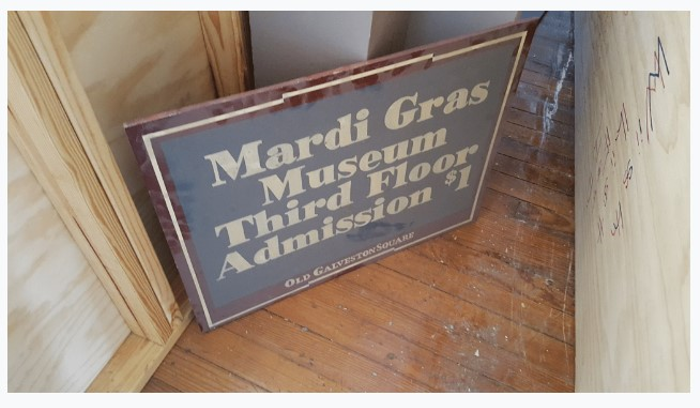
Located on the third floor of Old Galveston Square on the Strand
between 22nd and 23rd Streets, admission to the Mardi
Gras Museum was only $1 and inside was a thoughtful and splendidly sentimental
monument to the beloved holiday. It brought all of the spectacle and wonder
down from the balconies and off of the mammoth parade floats and presented it
within arm’s reach; it was a glittering and vibrant tribute to all of the
intricate details that brought Mardi Gras to life each year.
Designed by the Eubanks Architecture Group,
the perimeters of the museum were outfitted with custom stained glass and a
brief history of Galveston Mardi Gras inscribed on the wall. Joseph Rozier, who
was then a recent college graduate employed by the Eubanks firm, produced
design drawings for the layout of the museum and continued to assist with
creating exhibits after it opened. He explains that several permanent displays flanked
a large, central gallery that hosted revolving exhibits, the most dramatic of
which was an enormous hanger fixed to the ceiling that allowed the museum to
interchange many examples of the magnificent, 12-foot long capes worn by former
queens and duchesses.
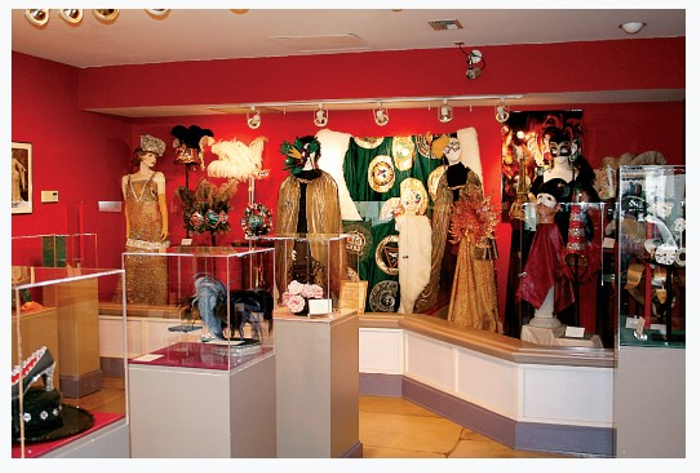 The permanent exhibits included donated items
from several Galveston Krewes. They featured early 20th century
costumes and various collections of historic memorabilia, like the custom
doubloons that were created by each Krewe every year. But garnering the most
attention were the three-dimensional models of the arches that were
commissioned by Mitchell to adorn the city streets in 1986. Seven world-famous
architects were asked to each design a “fantasy arch” for a Galveston intersection, a modern-day take on
the decorative arches that were erected for the 19th century
celebrations.
The permanent exhibits included donated items
from several Galveston Krewes. They featured early 20th century
costumes and various collections of historic memorabilia, like the custom
doubloons that were created by each Krewe every year. But garnering the most
attention were the three-dimensional models of the arches that were
commissioned by Mitchell to adorn the city streets in 1986. Seven world-famous
architects were asked to each design a “fantasy arch” for a Galveston intersection, a modern-day take on
the decorative arches that were erected for the 19th century
celebrations.
“The arches were built to be temporary,” says
Rozier, but the Pelli arch at 21st and Mechanic, lit by a series of
colored bulbs in a horizontal pattern, was kept up for six months. Gray’s arch
on the Strand also hung on for a significant
amount of time, and the Powell arch at 24th and Mechanic was rebuilt
and reinforced and remains to this day.
The project was distinguished by a 1987
exhibit at the Cooper-Hewitt
Museum, the national
museum of the Smithsonian Institution. “Arches of Galveston” included architectural renderings,
photographs, and models of each of the seven arches.
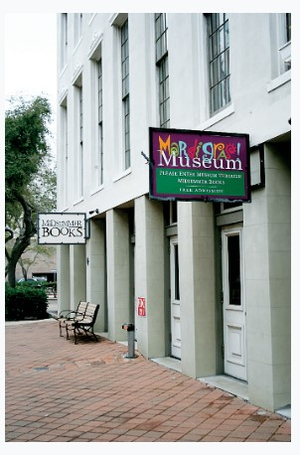 Unfortunately, the 3rd floor
location of the Mardi Gras Museum would prove a disadvantage. “Even though we
had an elevator and an escalator at the time, we simply didn’t get enough foot
traffic,” explains Rozier. “It was a labor issue, predominantly,” he continues,
“it required a full-time employee to staff the cash register to take admission
and sell merchandise [from the gift shop].” In 1996 the space was abandoned and
a satellite museum was opened across from the Tremont House, a location that
provided a comprehensive solution.
Unfortunately, the 3rd floor
location of the Mardi Gras Museum would prove a disadvantage. “Even though we
had an elevator and an escalator at the time, we simply didn’t get enough foot
traffic,” explains Rozier. “It was a labor issue, predominantly,” he continues,
“it required a full-time employee to staff the cash register to take admission
and sell merchandise [from the gift shop].” In 1996 the space was abandoned and
a satellite museum was opened across from the Tremont House, a location that
provided a comprehensive solution.
A local bookstore named Midsummer Night Books
occupied the storefront space of a building owned by Mitchell Historic
Properties at 2309 Mechanic. The owner agreed to play host to the museum, which
would be moved to a small annex next door at 2311. A thick concrete wall
separated the two addresses, but a portion of it was dismantled to create a
connecting passageway.
The gift shop was eliminated and the museum
was free and open to the public during the bookshop’s normal operating hours,
which removed the need for staff. Most importantly, foot traffic from the bookstore
and the hotel provided a much-desired visibility for the fascinating
collection.
“We moved the nicer things down to the
smaller annex, and gave all of the donated items back to the Krewes,” Rozier
recalls. A local artist named Cara Moore was hired to paint the floor with a
faux stone finish embellished with symbols of Mardi Gras, and a massive,
antique wooden display case featured a 1930s costume complete with headdress,
cape, and a stunning silver dress studded with thousands of sequins.
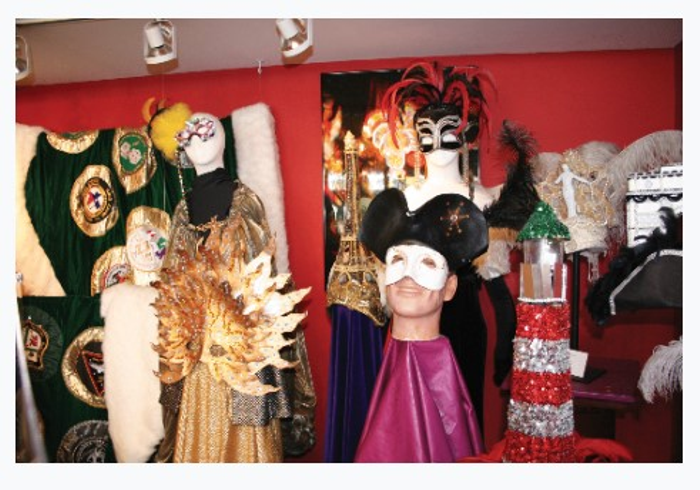 The Mardi Gras Museum remained a fixture of
downtown until Hurricane Ike in 2008, when a fast-rising storm surge prevented
the rescue of the museum’s already minimal contents. After the storm, neither
the bookstore nor the museum returned.
The Mardi Gras Museum remained a fixture of
downtown until Hurricane Ike in 2008, when a fast-rising storm surge prevented
the rescue of the museum’s already minimal contents. After the storm, neither
the bookstore nor the museum returned.
Today, the former location of Midsummer Night
Books and George’s museum is still owned by Mitchell Historic Properties and
currently houses one of Galveston’s
most dynamic art galleries, Arts on Mechanic.
Tour the Traces of
Galveston’s Mardi Gras Museum
Perhaps as a tongue-in-cheek
tribute to the Lenten season, the Mardi Gras Museum left behind several Easter
eggs when it closed. Some of them are (much) more obvious than others, but they
all blend in seamlessly with Galveston’s
Carnival identity.
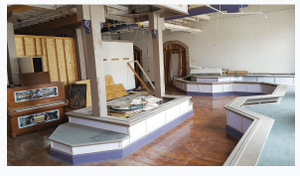 Powell Arch at 24th
and Mechanic
Powell Arch at 24th
and Mechanic
On the east side of the
intersection of 24th Street and Mechanic, the Powell arch turned 30
last year and still beams brightly every night as a constant reminder of
Galveston’s Mardi Gras heritage.
Floor & Passageway at
Arts on Mechanic
Step inside the local art
gallery at 2309 Mechanic and look down. Much of the floor painted by Galveston artist Cara
Moore for the Mardi Gras Museum still remains. The annex and the wide
passageway created to connect it to the bookstore now gives an added dimension
to the storefront space.
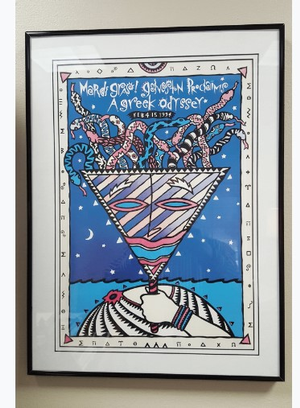 Antique Display Case at Arts
on Mechanic
Antique Display Case at Arts
on Mechanic
In the annex of Arts on
Mechanic where the museum was located, the large, antique display case used for
the luminescent silver costume survived Ike and has stayed in place through
several businesses.
Light Fixture at Davidson
Ballroom
Inside Davidson Ballroom, the
Tremont House’s private party venue located across the street from the hotel,
attendees often use a beautiful stained glass light fixture as their backdrop
for photographs during special events. The fixture was originally incorporated
into a display at the first museum location on the Strand.
Stained Glass at Old Galveston Square
Over the entrance to the
original museum space on the third floor of Old Galveston
Square on the Strand, a stained glass window
with the image of a jester still remains to welcome visitors.